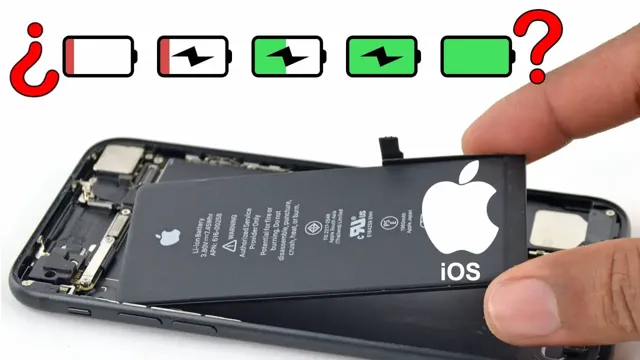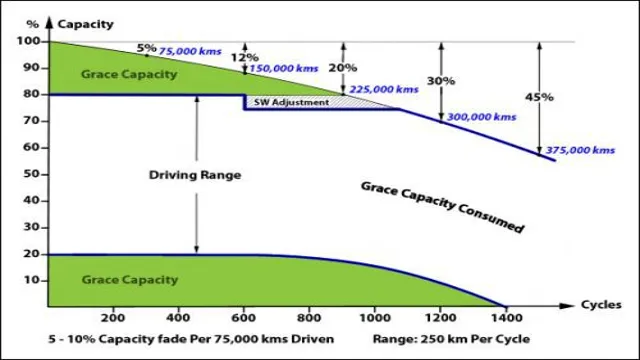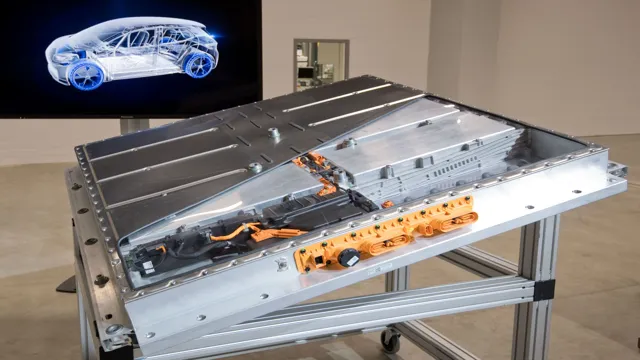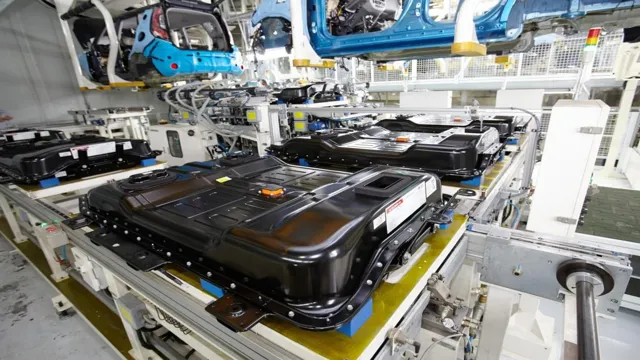Revving Up Your Knowledge: Understanding Electric Car Battery Charge Cycles
Electric cars are becoming increasingly popular. With their eco-friendliness and low carbon footprint, it’s not surprising that more and more people are starting to use these vehicles as their primary means of transportation. However, one of the biggest questions people have when it comes to electric cars is how often they need to charge their batteries.
The answer to this question lies in the concept of electric car battery charge cycles. Charge cycles refer to the process of discharging and recharging a battery. The number of charge cycles a battery can go through before it starts to degrade depends on various factors, including the battery’s chemistry, temperature, and usage patterns.
Generally speaking, the more charge cycles a battery goes through, the lower its overall capacity will be. So how often should you be charging your electric vehicle’s battery? It depends on the type of battery you have and how you use your car. Lithium-ion batteries, which are commonly used in electric cars, can typically handle anywhere between 500 and 1000 charge cycles before they start to degrade significantly.
This means that if you’re using your electric car every day and charging it every night, you could be looking at needing a replacement battery anywhere from 2 to 5 years from now. Understanding electric car battery charge cycles is important not just for knowing when to replace your battery, but also for maximizing its life span. By properly managing your battery’s charge cycles and avoiding extreme temperatures, you can ensure that your electric car battery lasts for years to come.
What are Charge Cycles?
Electric car battery charge cycles refer to the number of times the battery can be charged and discharged before it starts to degrade and lose its maximum capacity. An electric vehicle’s battery pack is made up of several individual cells that store electrical energy. Each time the battery is charged and discharged, it contributes to the overall battery cycle count.
Most modern electric cars are equipped with lithium-ion batteries that typically have a lifespan of 500 to 1,500 cycles, depending on several factors such as driving habits, weather conditions, and how frequently the battery is charged. A high number of charge cycles indicates a longer battery life, which is why EV manufacturers often provide warranties based on the battery’s cycle count. It’s important to monitor your vehicle’s battery health and charging habits to ensure it lasts for as many cycles as possible.
Explaining Charge Cycles in Electric Car Batteries
Charge Cycles Charge cycles refer to the process of charging and discharging an electric car battery. Every time an electric car battery is charged and discharged, it goes through a single charge cycle. Electric car batteries have a certain limit to how many charge cycles they can go through before they start to lose their capacity to hold a charge.
This limit is known as the battery’s cycle life. The number of charge cycles a battery can handle before its performance declines depends on its type and the conditions in which it’s used. Simply put, the more you use your electric car’s battery, the more charge cycles it goes through, and the quicker its battery life is depleted.
It’s important for electric car owners to understand the concept of charge cycles to maintain the longevity of their car’s battery and to plan for its replacement appropriately.

Types of Charge Cycles: Depth and Frequency
Charge cycles refer to the process of charging and discharging a battery. Every time a battery goes through one complete cycle of being fully charged and discharged, it loses some of its capacity. This reduction in capacity becomes more pronounced over time, leading to decreased battery life.
There are two main types of charge cycles: depth and frequency. Depth refers to how much of a battery’s capacity is used during each cycle. A shallow cycle involves using only a small percentage of the battery’s capacity, whereas a deep cycle involves fully discharging the battery.
Frequency refers to how often a battery is charged and discharged. A battery that is used and recharged every day will have a different cycle life than a battery that is used and recharged once a week. Understanding the different types of charge cycles is important in optimizing battery life and performance.
By properly managing the depth and frequency of charge cycles, it is possible to extend battery life and maintain optimal performance over time.
How Charge Cycles Affect Battery Life
When it comes to maintaining an electric car battery, understanding the role of charge cycles is crucial. Each time you charge and drain your battery, it’s considered one charge cycle. The number of charge cycles your electric car battery can undergo before it starts losing its capacity varies based on the type of battery and usage patterns.
It’s important to note that the total number of charge cycles shouldn’t be the sole determinant of battery life. How you use your vehicle and the way you charge it also have an impact. For example, if you frequently let the battery fully drain before recharging it, you’ll likely see a shorter lifespan.
On the other hand, if you aim for partial charges, the battery will generally last longer. So, to get the most out of your electric car battery, be mindful of how you charge it and try to avoid full discharge cycles. By doing so, you can slow down the battery degradation process and extend its overall lifespan.
Determining a Battery’s Maximum Charge Cycles
Determining a battery’s maximum charge cycles is an essential factor in ensuring its longevity and usability. Charge cycles refer to the number of times a battery can be charged and discharged before its capacity is significantly reduced. Manufacturers test their batteries to estimate their maximum charge cycles, and this number varies depending on the make and model of the battery.
Understanding a battery’s maximum charge cycles is vital because overcharging or undercharging it can significantly reduce its lifespan. Properly caring for a battery by following the manufacturer’s instructions and regularly charging it can increase its longevity and prevent it from being damaged. By determining a battery’s maximum charge cycles and taking care of it, its capacity can remain high, and it can continue to be used for an extended period, saving money in the long run.
How Charge Cycles Affect Battery Capacity and Performance
When it comes to battery life and performance, understanding charge cycles is essential. Charge cycles refer to the process of charging and discharging a battery, and each cycle affects the overall capacity and performance of the battery. Every time you charge your device, you are using one charge cycle.
Over time, the number of charge cycles a battery can handle decreases, leading to reduced battery capacity and performance. Lithium-ion batteries, which are commonly used in modern electronics, have a limited number of charge cycles they can withstand before their ability to hold a charge decreases significantly. This can lead to decreased battery life and the need for more frequent charging.
So, it’s essential to be mindful of your device’s battery usage and charging habits to ensure the longevity and optimal performance of your battery.
Factors that Affect the Number of Charge Cycles
The number of charge cycles a battery can handle is affected by a variety of factors, including the technology used in the battery, the temperature at which the battery is stored, and the way in which the battery is charged. Each type of battery has a different number of expected charge cycles, with some batteries able to handle more cycles than others. Additionally, storing a battery at high temperatures can decrease the number of charge cycles it can handle, so it’s important to keep batteries in a cool, dry place when not in use.
Finally, charging a battery in a way that is not recommended by the manufacturer can also decrease its overall lifespan. To ensure maximum battery life, it’s important to follow the manufacturer’s recommendations for charging and storage, as well as to choose high-quality batteries made with advanced technology. By doing so, you can ensure that your batteries provide optimal performance and last for as long as possible.
Maximizing Your Battery’s Charge Cycles
If you own an electric car, one of the most important things to consider is how to maximize your battery’s charge cycles. Each time you charge your battery, it counts as one cycle, and over time, the battery’s capacity to hold a charge will decrease. However, there are several ways in which you can extend the lifespan of your battery.
Firstly, avoid charging your battery to 100% unless necessary, as this puts extra strain on the battery and can shorten its lifespan. Secondly, avoid letting your battery run completely flat, as this can also cause damage. Instead, aim to keep your battery charge between 20% and 80% whenever possible.
Additionally, try to charge your battery at a slower rate, as this can help to reduce the wear and tear on the battery. Finally, avoid exposing your battery to extreme temperatures, as this can also contribute to degradation. By taking good care of your electric car battery, you can maximize its charge cycles and get the most out of your investment.
Tips to Prolong Battery Life
When it comes to prolonging your battery life, maximizing its charge cycles is essential. To do this, consider minimizing how often you charge your device throughout the day, and instead, aim for one full charge each day. It’s also crucial to avoid charging your battery to 100% as often as possible.
Instead, aim to keep your battery level somewhere in the 20-80% range. This prevents your battery from overworking and ultimately shortening its overall lifespan. Additionally, consider keeping your battery cool, as high temperatures can lead to faster degradation.
By following these simple tips, you can maximize your battery’s charge cycles and keep your device running smoothly for longer.
Maintenance Practices for Electric Car Batteries
As electric cars become more common, it’s important to understand how to properly maintain their battery systems. Electric car batteries have a limited number of charge cycles, and maximizing those cycles is key to getting the most out of your car’s battery life. One important factor is to avoid regularly charging your battery to 100%.
While it may seem like a good idea to fully charge your battery before each use, it’s actually better to keep it between 20-80% for the majority of its lifespan. Additionally, it’s important to avoid letting the battery sit at a low charge for long periods of time. Keeping your battery charged and avoiding extreme temperatures will also help to prolong the life of the battery.
By following these simple maintenance practices, you can maximize your electric car’s battery life and get the most out of your investment.
Conclusion
In the world of electric car batteries, charge cycles are the ultimate dictator of lifespan and performance. It’s like the saying goes, “you only have so many cycles in the battery game”. But fear not, with advancements in technology and our increasing awareness of environmentally friendly alternatives, we may soon see a future where electric cars rule the road and charge cycles become a thing of the past.
Until then, make sure to give your battery the TLC it deserves, because in this game, every cycle counts.”
FAQs
What is a charge cycle for an electric car battery?
A charge cycle is the process of charging an electric car battery from empty to full and then discharging it back to empty again.
How many charge cycles can an electric car battery undergo?
Most electric car batteries are designed to last for 1000 to 2000 charge cycles, depending on the specific model.
What factors can affect the lifespan of an electric car battery?
The lifespan of an electric car battery can be affected by factors such as temperature, usage patterns, and charging habits.
How can I extend the lifespan of my electric car battery?
To extend the lifespan of your electric car battery, you should avoid exposing it to extreme temperatures, try to maintain a consistent charging routine, and avoid running the battery down to zero on a regular basis.






